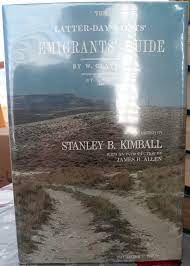Articles/Essays – Volume 18, No. 2
Emigrant Guides | Stanley B. Kimball, ed., The Latter-day Saints’ Emigrants’ Guide by W. Clayton
The story of the western movement runs deep in American and Mormon history. The rolling of wagons west toward Oregon, California, and Utah is as basic to our national experience as Plymouth Rock and Independence Hall. Sunbonneted women, sun-browned men, gallant leaders, hostile Indians, white-topped covered wagons, and sturdy oxen are familiar to the pioneer saga, but little known is the role of guidebooks. Few pioneers blazed new trails as they traveled west. Almost always they followed in the wagon tracks of an earlier group and usually with some kind of published emigrant guide to keep them on course.
Between 1842 and 1868 at least thirty four emigrant guides were published dealing with the pioneer trail in Wyoming and Utah, and most were worthless as either emigrant or trail guides. One guide book, Lansford W. Hastings, The Emigrants’ Guide to Oregon and California, has been branded dangerous because of its association with the Donner-Reed tragedy of 1846.
The most valuable trail guides were those which took the traveler place by place and mile by mile from the eastern terminus to the western destination. The best is William Clayton’s The Latter-day Saints’ Emigrants’ Guide. Published in 1848, the twenty-four-page guide is well known among students of Mormon history. It has been reprinted several times, notably as a facsimile appendix to Volume Three of B. H. Roberts’s six-volume work, A Com prehensive History of the Church of Jesus Christ of Latter-day Saints.
The value of this 1983 edition is the biographical introduction to William Clay ton penned by James B. Allen and the preface and notes provided by the long-time Mormon trail scholar, Stanley B. Kimball. It will find wide use by those interested in western trails, the Mormon pioneers’ trek to Utah, and William Clayton.
In his biographical introduction, Allen outlines the life of this 1837 English convert to Mormonism and his career as a clerk, scribe, and recordkeeper. Clayton’s contributions to Mormon and Western American heritage were significant and include the Mormon anthem, “Come, Come Ye Saints,” and his journal, described as “one of the finest firsthand accounts available of the memorable crossing of the plains by the vanguard company of Mormon pioneers,” (p. 1) and The Latter-day Saints’ Emi grants’ Guide.
Stanley Kimball’s preface puts Clay ton’s immigrant guide in historical perspective, noting that it was the first and best guide to the Far West and was used by Mormon and non-Mormon travelers, especially California goldseekers. Kimball writes:
Clayton provided, above all things, conciseness, accuracy, and practicality. He had furthermore, personally been over the route two times. He did not clutter up his pages with philosophical musings, fine writing, or any personal allusions. He clearly and briefly guided the emigrant from one identifiable feature (especially water sources) to another, giving the carefully measured distances between them and a cumulative list of miles traveled from Winter Quarters on the Mis souri River as well as miles remaining to the City of the Great Salt Lake. His measurement of distances is his single most important contribution, (p. 31)
The well-known story is recounted of the concern for an accurate measurement of the Mormon trail, the disagreements by the 1847 pioneer company over mileage estimates, Clayton’s discovery that 360 rotations of a wheel on Heber C. Kimball’s wagon equalled one mile, his careful counting of the wagon wheel revolutions to compute an accurate distance, and the invention and production of a roadometer to measure the distance.
Kimball assesses the influences or possible influences on Clayton’s work of earlier travel accounts, guides, maps, and contacts. He also reviews the shortcomings of the Guide—the lack of advice on preparing for the westward trek and how to protect emigrants from Indians—but finds it difficult to assess how much Clayton’s guide was used by Mormon emigrants. The editor has located only three references to the guide in Mormon trail accounts and suggests that the guide was perhaps of little value after the first few years of Mormon immigration—because of the large number of non-English speaking converts, the fact that the trail was well known, and because most Mormon companies included individuals well acquainted with the trail. Nevertheless in 1848 the 5,000 published copies sold for $5 each with offers of $25 reported when the guidebook was unavailable.
Included in the edition is a section of contemporary maps of the Mormon Trail taken from the editors’ 1979 volume Dis covering Mormon Trails, and three historical maps: the 1823 map by Major Stephen H. Long of the country drained by the Mississippi River; the 1843 Fremont-Preuss map of the Platte River; and Mitchell’s 1846 map of Texas, Oregon, and California. Seventeen black-and-white photographs of the trail are included, though most are of questionable quality. More and better quality photographs would help to illustrate and document the trail more effectively, while more detailed maps of the trail would enhance the book’s value as a present-day guide to the Mormon trail.
The Latter-day Saints’ Emigrants’ Guide by W. Clayton, edited by Stanley B. Kimball with a biographical introduction by James B. Allen (Gerald, Missouri: The Patrice Press, 1983), 107 pp., $9.95.


 Back to full Issue
Back to full Issue

